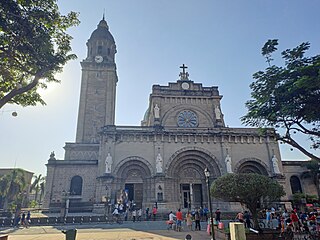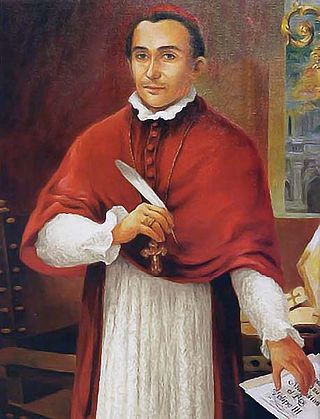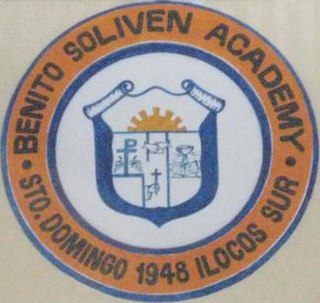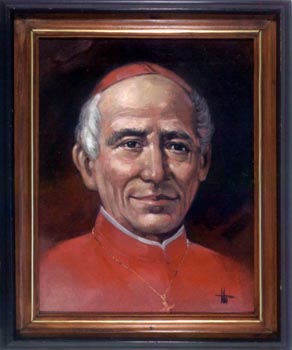
The Archdiocese of Manila is the archdiocese of the Latin Church of the Catholic Church in Metro Manila, Philippines, encompassing the cities of Manila, Makati, San Juan, Mandaluyong, Pasay, and Taguig. Its cathedral is the Minor Basilica and Metropolitan Cathedral of the Immaculate Conception, also known as the Manila Cathedral, located in Intramuros, which comprises the old city of Manila. The Blessed Virgin Mary, under the title Immaculate Conception, is the principal patroness of the archdiocese.

Lal-lo, officially the Municipality of Lal-Lo, is a first class municipality in the province of Cagayan, Philippines. According to the 2020 census, it had a population of 48,733 people.

The Archdiocese of Cáceres is a Latin Church archdiocese of the Catholic Church in the Philippines. It is a metropolitan see that comprises the Bicol Region, while directly overseeing the third, fourth, and fifth congressional districts of Camarines Sur, Naga City, Iriga City and the Municipality of Gainza. The archdiocese, having been founded in 1595 in Nueva Cáceres, is also considered one of the oldest dioceses in the Philippines with Cebu, Segovia and Manila, and once had jurisdiction that stretched from Samar in the south and Isabela Province in the north. The seat of the archdiocese is currently located in Naga City, also known as the Queen City of Bicol.

The Archdiocese of Cebu is a Latin Church archdiocese of the Catholic Church in the Philippines and one of the ecclesiastical provinces of the Catholic Church in the country. It is composed of the entire civil province of Cebu. The jurisdiction, Cebu, is considered as the fount of Christianity in the Far East.

The Roman Catholic Archdiocese of Cagayan de Oro is an archdiocese of the Catholic Church in the Philippines.

The Roman Catholic Archdiocese of Tuguegarao is a Latin Church metropolitan archdiocese of the Catholic Church in the Philippines. Tuguegarao is a river delta city that became center of the archdiocese in the province of Cagayan, on the island of Luzon. Its seat is located at the Saint Peter the Apostle Metropolitan Cathedral.

Salvador Lazo y Lazo was a Filipino prelate of the Roman Catholic Church. A Traditionalist Catholic, he served as Bishop of San Fernando de La Union from 1981 to 1993, later on his life he joined the Society of Saint Pius X.

Miguel de Benavides y Añoza, O.P. was a Spanish clergyman and sinologist who was the third Archbishop of Manila. He previously served as the first Bishop of the Diocese of Nueva Segovia, and was the founder of the University of Santo Tomas in Manila.

The Diocese of Laoag is a Latin Church ecclesiastical jurisdiction or diocese of the Catholic Church in the Philippines.

Benito Soliven Academy is a private secondary school under the Roman Catholic order, conceived by Rev. Fr. Mariano Flores Pacis, parish priest of Santo Domingo, located in Poblacion Santo Domingo, Ilocos Sur. The Academy was run by the Diocese of Santo Domingo, but the operation, management and supervision were later transferred to the Roman Catholic Archdiocese of Nueva Segovia, during the time of Archbishop Msgr. Juan C. Sison. The Archdiocesan School Board of Trustees and corporators was organized with the Archbishop as the chairman. The parish priest automatically becomes the School Director unless otherwise another one is appointed by the Archdiocesan Chairman.

The Cathedral of St. William the Hermit, also known as the San Fernando Cathedral, is the seat of the Roman Catholic Diocese of San Fernando de La Union, in the Philippines. The diocese, which comprises the civil province of La Union, was created on January 19, 1970, and canonically erected on April 11, 1970, with Saint William the Hermit as the titular saint. It is a suffragan of the Archdiocese of Lingayen-Dagupan. Prior to the creation of the diocese, the church was formerly under the Archdiocese of Nueva Segovia.

The Saint Catherine of Alexandria Parish Church, commonly known as the Tayum Church, is a 19th-century Baroque Roman Catholic church located at Brgy. Poblacion, Tayum, Abra, Philippines. The parish church, under the patronage of Saint Catherine of Alexandria, is under the jurisdiction of the Roman Catholic Diocese of Bangued. The church, together with 25 other Spanish-era churches, was declared a National Cultural Treasure by the National Museum of the Philippines in 2001. Its current parish priest is Fr. Roderick Ardaniel, who succeeded Fr. Ruben Valdez.

The Metropolitan Cathedral and Parish of the Conversion of Saint Paul, commonly known as Vigan Cathedral, is a Catholic cathedral in Vigan, Ilocos Sur, Philippines. It contains Archdiocese of Nueva Segovia cathedra. It is part of the UNESCO World Heritage Site declaration for the Historic Town of Vigan in 1999.

Leopoldo C. Jaucian is a Roman Catholic Bishop of the Philippines and the current Bishop of Bangued in Abra (Philippines).

David William Valencia Antonio is a Philippine prelate of the Catholic Church who serves as the Bishop of the Diocese of Ilagan in Isabela.

Miguel García Serrano, O.S.A. was a Roman Catholic prelate who served as the Archbishop of the Roman Catholic Archdiocese of Manila (1618–1629) and the Bishop of the Diocese of Nueva Segovia (1616–1618).

Alfredo Verzosa y Florentín was the fourth native Filipino to be elevated as Bishop of the Roman Catholic Church and the first from Northern Luzon – the first Ilocano. Together with Laura Latorre Mendoza, a widow and catechist, they founded the Congregation of the Missionary Catechists of the Sacred Heart (MCSH), a congregation focusing on the missions of education and administration within the church, especially of Catholic catechesis. His cause for beatification is currently underway, having been declared Servant of God by Pope Benedict XVI.

Juan Danilo Bangayan Ulep is a Filipino bishop of the Catholic Church. He is the fifth and current Bishop-Prelate of Batanes and was elected as the Chairman of the Episcopal Commission on Cultural Heritage of the Church during the 126th Plenary Assembly of the Catholic Bishops' Conference of the Philippines.










































